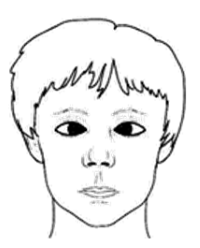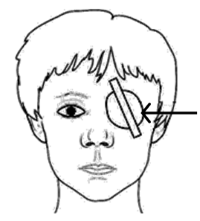How you can help a pupil with a squint
What is a squint?
There are many different types of squint. The most common squint is where one eye turns inwards or outwards. A squint may be present some or all of the time. Glasses for long or short sight can sometimes correct it.

Convergent squint.

Divergent squint.

Eye patch over 'good' eye.
How is sight affected?
The brain finds it confusing when the eyes are focusing in slightly different directions. Its reaction to this is usually to block out the information from the squinting eye.
This can result in permanent reduction of vision in one eye if left untreated. Other children may react by developing double vision.
How can we help the children with a squint?
Nursery staff and teachers should be informed of any child undergoing squint treatment i.e. patching, wearing glasses, eye drops, surgery. If a child in your care has a squint which is untreated, ask the parents to take him to the optician.
- Patching – staff in charge need to know which eye is to be patched and for how long.
- If the child is relying on the weaker eye, for the period of the patching he/she may be at a visual disadvantage. This may affect hand/eye coordination.
- During this time, the child should be given work which is bold, clearly laid out and well-contrasted. He/she may work at a slower rate than previously and tire more easily. The child can still be encouraged to take part in all activities.
- Correct classroom positioning is very important as the field of vision on the patched side will be reduced.
- If treatment is not successful the child may be left with useful vision in one eye only.
- You can find further advice in the Monocular Vision guide.
- Ensure that, unless told otherwise, glasses are worn for all activities including play and P.E., as they are part of the squint management treatment.
Please note: If a child suddenly develops a squint where previously he/she did not have one, it is important that the cause of it be medically investigated as soon as possible.
Further information
Further help and advice is available from the Specialist Support Service Visual Impairment Team.
Address:
Staffordshire Place 2,
Tipping Street
Stafford
ST16 2DH
Phone: (01785) 356830
Minicom: (01785) 356835
Fax: (01785) 356841
Email: sss.service@staffordshire.gov.uk
If you, or someone you know, would like a copy of this in large print, braille, an audio tape or in languages other than English, please contact the Visual Impairment Team on 01785 356830.
Disclaimer
For further information please see our disclaimer.